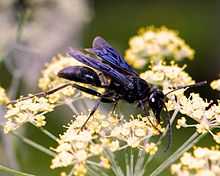Sphex pensylvanicus
| Sphex pensylvanicus | |
|---|---|
 | |
| Scientific classification | |
| Kingdom: | Animalia |
| Phylum: | Arthropoda |
| Class: | Insecta |
| Order: | Hymenoptera |
| Family: | Sphecidae |
| Genus: | Sphex |
| Species: | S. pensylvanicus |
| Binomial name | |
| Sphex pensylvanicus Linnaeus, 1763 | |
| Synonyms [1] | |
| |
Sphex pensylvanicus is a species of digger wasp, commonly known as the great black wasp.[2] It lives across most of North America and grows to a size of 20–35 mm (0.8–1.4 in). The larvae feed on living insects that the females paralyze and carry to the underground nest.
Distribution
S. pensylvanicus is distributed across most of the Continental United States except in the north-west, in Canadian provinces of Ontario and Quebec,[3] and also in northern Mexico.[2] The northernmost localities in which it has been reported are Freedom, New Hampshire, Malden, Massachusetts, West Buxton, Maine, and Amherst, Massachusetts, as well as locations in the states of New York, Vermont, Indiana, Michigan, and Minnesota.[1]
Description
Sphex pensylvanicus is a large, black wasp, significantly larger than its congener Sphex ichneumoneus (the great golden digger wasp).[4] Males are smaller than females, at only 19–28 mm (0.7–1.1 in) long, to females 25–34 mm (1.0–1.3 in).[1] According to John Bartram, "The Sting of this Wasp is painful, but does not swell like others".[5] As well as being larger than S. ichneumoneus, it is also darker, with smoky wings and an entirely black body, where S. ichneumoneus has yellow wings, red legs, and a partly red abdomen.[6]
Ecology and life cycle
Adult females of S. pensylvanicus build an underground nest which they provision with various orthopteran insects,[7] particularly of the genera Microcentrum, Amblycorypha and Scudderia.[4] Prey are stung three times, once in the neck and twice in the thorax, and are paralyzed by the wasp's sting, although they can survive for weeks.[1] The prey are then carried to the nest. While collecting their prey, the females are vulnerable to kleptoparasitism, in which birds, including the house sparrow (Passer domesticus) and the gray catbird (Dumetella carolinensis), steal the prey that the wasp has collected.[7]
The eggs of S. pensylvanicus are 5–6 mm (0.20–0.24 in) long and 1 mm (0.04 in) wide; they are glued to the underside of the prey insect between the first and second pairs of legs.[1] Each of the several chambers in the nest houses a single larva, which consumes 2–6 katydids or grasshoppers.[7] The larvae live for 10 days, reaching a final size of 30–35 mm (1.2–1.4 in) long by 7–10 mm (0.28–0.39 in) wide.[1]
S. pensylvanicus is an important pollinator of plants including the milkweeds Asclepias syriaca and A. incarnata.[8] It has also been reported on Daucus carota, Eryngium yuccifolium and Melilotus albus.[9] S. pensylvanicus is one of several species of Sphex to be parasitized by the strepsipteran Paraxenos westwoodi.[10]
Taxonomic history
Sphex pensylvanicus was the subject of the first article on an insect written by a native of the New World,[1][11] when observations made by John Bartram on S. pensylvanicus were presented to the Royal Society in 1749 by Peter Collinson.[5] Sphex pensylvanicus was described by Carl Linnaeus in his 1763 work Centuria Insectorum, using material sent to him by Charles De Geer.[12]
References
- ↑ 1.0 1.1 1.2 1.3 1.4 1.5 1.6 John H. Frisch (1938). "The life-history and habits of the digger-wasp Ammobia pennsylvanica (Linn.)". American Midland Naturalist 19 (3): 673–677. doi:10.2307/2420481. JSTOR 2420481.
- ↑ 2.0 2.1 Richard Mitchell Bohart & Arnold S. Menke (1976). Sphecid Wasps of the World: a Generic Revision. University of California Press. ISBN 978-0-520-02318-5.
- ↑ Species Sphex pensylvanicus - Great Black Wasp, BugGuide
- ↑ 4.0 4.1 H. Jane Brockmann (1985). "Provisioning behavior of the great golden digger wasp, Sphex ichneumoneus (L.) (Sphecidae)". Journal of the Kansas Entomological Society 58 (4): 631–655. JSTOR 25084707.
- ↑ 5.0 5.1 Peter Collinson (December 21, 1749). "A Description of the Great Black Wasp, from Pensylvania, as communicated from Mr. John Bartam to Mr. Peter Collinson, F. R. S.". Philosophical Transactions of the Royal Society 46 (491–496): 278–279. doi:10.1098/rstl.1749.0050. JSTOR 104640.
- ↑ Ross H. Arnett (2000). "Tribe Sphecini". American Insects: a Handbook of the Insects of America North of Mexico (2nd ed.). CRC Press. p. 595. ISBN 978-0-8493-0212-1.
- ↑ 7.0 7.1 7.2 Justin Benttinen & Evan Preisser (2009). "Avian kleptoparasitism of the digger wasp Sphex pensylvanicus" (PDF). Canadian Entomologist 141 (6): 604–608. doi:10.4039/n09-033.
- ↑ Elizabeth J. Farnsworth & Mario J. DiGregorio (December 2001). "Conservation and Research Plan: Asclepias purpurascens L., purple milkweed" (PDF). New England Wild Flower Society.
- ↑ Mark F. O'Brien (August 31, 2006). "Sphex pensylvanicus". The Sphecid Wasps of Michigan (Hymenoptera: Sphecidae: Sphecinae). University of Michigan. Retrieved June 22, 2010.
- ↑ Richard S. Miller, April M. Pearce, and Kevin M. O'Neill (2009). "Prevalence of stylopization of Sphex ichneumoneus (L.) (Hymenoptera: Sphecidae) by Paraxenos westwoodi (Templeton) (Strepsiptera: Xenidae)". Psyche 2009: 4 pp. doi:10.1155/2009/690125.
- ↑ Patricia Tyson Stroud (1995). "Forerunner of American conservation: naturalist Thomas Say". Forest & Conservation History 39 (4): 184–190. doi:10.2307/3983959. JSTOR 3983959.
- ↑ M. C. Day (1979). "The species of Hymenoptera described by Linnaeus in the genera Sphex, Chrysis, Vespa, Apis and Mutilla". Biological Journal of the Linnean Society 12 (1): 45–84. doi:10.1111/j.1095-8312.1979.tb00049.x.
External links
 Media related to Sphex pensylvanicus at Wikimedia Commons
Media related to Sphex pensylvanicus at Wikimedia Commons